
Quetzals are strikingly colored birds in the trogon family. They are found in forests, especially in humid highlands, with the five species from the genus Pharomachrus being exclusively Neotropical, while a single species, the eared quetzal, Euptilotis neoxenus, is found in Mexico and very locally in the southernmost United States. Quetzals are fairly large, slightly bigger than other trogon species. The resplendent quetzal is the national bird of Guatemala because of its vibrant colour.

The resplendent quetzal is a bird in the trogon family. It is found from Chiapas, Mexico to western Panama. It is well known for its colorful plumage. There are two subspecies, P. m. mocinno and P. m. costaricensis.

The golden-headed quetzal or corequenque is a strikingly coloured bird in the genus Pharomachrus; it is also referred to as Trogon auriceps. It is found in moist mid-elevation forests from eastern Panama to northern Bolivia.

The Andean cock-of-the-rock, also known as tunki (Quechua), is a large passerine bird of the cotinga family native to Andean cloud forests in South America. It is widely regarded as the national bird of Peru. It has four subspecies and its closest relative is the Guianan cock-of-the-rock.

The eared quetzal, also known as the eared trogon, is a near passerine bird in the trogon family, Trogonidae. It is native to streamside pine-oak forests and canyons in the Sierra Madre Occidental of Mexico south to western Michoacán and southeasternmost Arizona in the United States. This range includes part of the Madrean Sky Islands region of southeastern Arizona, southwestern New Mexico, and northern Sonora.

The fawn-breasted brilliant is a species of hummingbird. It is native to South America, where it occurs in Bolivia, Colombia, Ecuador, and Peru.

The black-and-chestnut eagle is a South American species of bird of prey in the family Accipitridae. It is sometimes called Isidor's eagle. It is often placed in the monotypic genus Oroaetus. However, recent genetic testing indicates that this species is fairly closely related to Spizaetus species and thus the species should be included in that genus.

The plushcap is a species of bird in the tanager family Thraupidae and it is the only member of the genus Catamblyrhynchus.

The red pileated finch, also known as the red-crested finch, is a species of bird in the family Thraupidae. It is found in Argentina, Bolivia, Brazil, Ecuador, French Guiana, Guyana, Paraguay, Peru, on the eastern side of the Andes. Its natural habitats are subtropical or tropical dry forests, subtropical or tropical moist lowland forests, subtropical or tropical dry shrubland, and heavily degraded former forest. This is a common species, and the International Union for Conservation of Nature has rated its conservation status as "least concern".

The violaceous jay is a species of bird in the family Corvidae, the crows and their allies.

The grey-mantled wren is a species of bird in the family Troglodytidae. It is found in Bolivia, Colombia, Ecuador, and Peru.

The fiery-throated fruiteater is a species of bird in the family Cotingidae. It is found in Colombia, Ecuador, and Peru where its natural habitats are subtropical or tropical moist lowland forests and subtropical or tropical moist montane forests. It is becoming rare due to habitat destruction of its rainforest habitat. Its population size and range are limited causing this species to be considered near threatened.
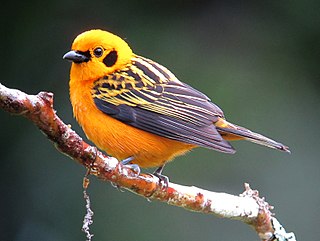
The golden tanager is a species of bird in the family Thraupidae. It is widespread and often common in highland forests of the Andes and Venezuelan Coastal Range in north-western South America.
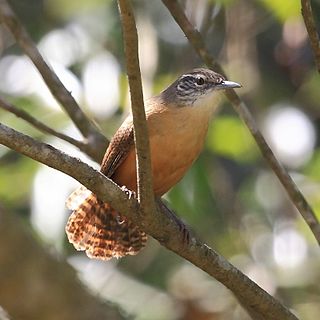
The buff-breasted wren is a species of bird in the family Troglodytidae. It is found in the Amazon Basin of northern Brazil and Amazonian Colombia, Ecuador, Peru and northern-border Bolivia, and also the Guianan countries of Guyana, Suriname, and French Guiana. It occurs in non-Amazonian regions of Venezuela and Colombia and its range extends into eastern Panama.
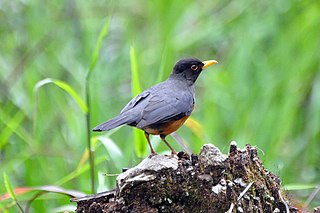
The chestnut-bellied thrush is a species of bird in the family Turdidae. It is found in Colombia, Ecuador, Peru, and Venezuela. Its natural habitats are subtropical or tropical moist montane forests and heavily degraded former forest.
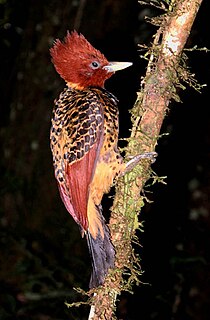
The rufous-headed woodpecker is a species of bird in the family Picidae. It formerly included Kaempfer's woodpecker as a subspecies.
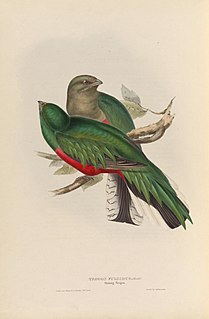
The white-tipped quetzal is a species of bird in the family Trogonidae found in Venezuela, Colombia, and Guyana. Two subspecies have been described. Pharomachrus fulgidus fulgidus is found in the mountains of northern Venezuela and Pharomachrus fulgidus festatus ranges through the Santa Marta mountains of northeast Colombia. Quetzals are iridescent and colourful birds found in forests, woodlands and humid highlands. The white-tipped quetzal has been a limited subject of research. Pharomachrus nests have been studied to analyse the effects of rainfall on breeding, however conclusions are based on single observations. On the IUCN Red list of threatened species, the white-tipped quetzal is listed as a species of least concern.

The pavonine quetzal is a species of bird in the family Trogonidae, the trogons. It is also known at the peacock trogon, red-billed train bearer, or viuda pico rojo in Spanish. The pavonine quetzal lives in the Neotropics, more specifically in the northern region of the Amazon basin, spreading from Colombia to Bolivia. The most notable characteristics helpful in identifying this bird are its plumage, red beak, and its distribution - it is the only quetzal occupying the lowland rainforest east of the Andes.

The black-tailed trogon is a species of bird in the family Trogonidae, the quetzals and trogons. It is found Panama and northern South America.
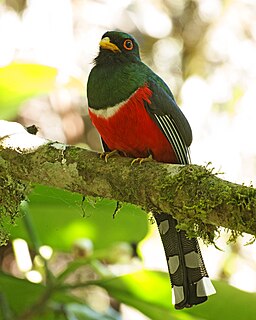
The masked trogon is a species of bird in the family Trogonidae. It is fairly common in humid highland forests in South America, mainly the Andes and tepuis.





















